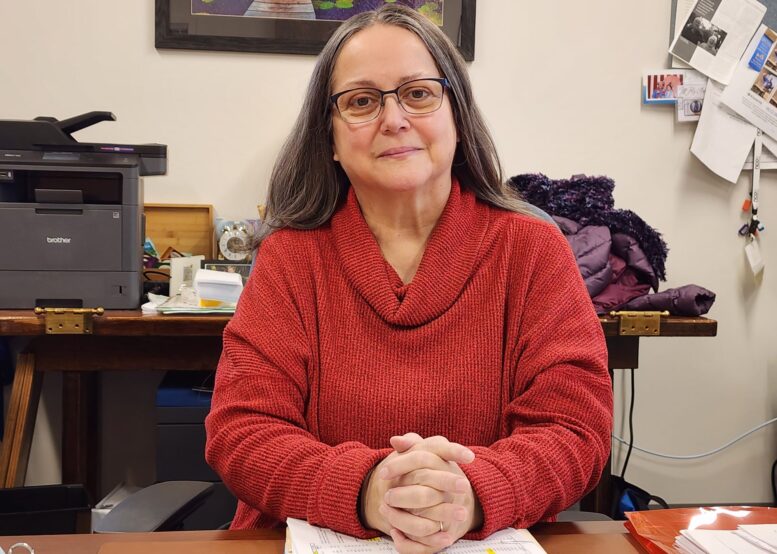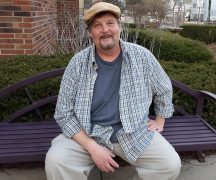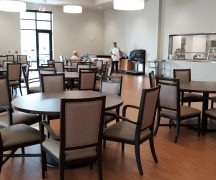By JAN McLAUGHLIN
BG Independent News
In December, COVID robbed Denise Niese of 25 pounds of muscle, her ability to breathe on her own, and at one point, the strength to even lift her head.
It has left Niese with the unfamiliar directive to be patient with herself.
As executive director of the Wood County Committee on Aging, Niese is accustomed to arriving at work early, staying late, and juggling multiple issues at once.
But last month, Niese was hospitalized with COVID-19 for 20 days – five of those days on a ventilator. Her customary stamina and spark have been dimmed. But that is only temporary, she is quick to remind.
She recalls feeling chilled at work on Dec. 7, and since her husband Dale had tested positive for COVID earlier in the week, Denise took a test in her office. It showed a very light positive result. She quickly fired off an email to her staff, “letting them know I would be out for the next five days,” as required by the senior center protocol.
That was a Thursday evening.
“By Saturday, I could barely lift my head,” Niese said.
Her oxygen levels had dropped to 85%, and she was immediately put in the ICU at Bay Park Hospital, near the Nieses’ home in Northwood. Her cardiologist and pulmonologist said she deteriorated quickly.
On Sunday (Dec. 10), she was intubated, and on Tuesday at 2 a.m., Dale got a phone call saying Denise needed to be placed on a ventilator.
“Her lungs just couldn’t give her body the oxygen it needed,” her husband said.
Having more than 40 years experience working in hospital labs, Dale knew the chances of someone surviving once put on a ventilator were 50-50.
“I knew it was serious,” he said.
After five days, hospital staff began weaning her off the vent.
Denise remembers little of this part of her hospitalization. Bit by bit, Dale is sharing with her the frightening details, like the two times her heart rate spiked over 200 while she was ventilated. And when she had to be paralyzed and put in a prone position to force more oxygen and help clear the lungs.
Once weaned off the vent, Denise had a persistent cough and congestion, and got little sleep.
She does recall her lungs and bronchial tubes being irrigated on Dec. 26 to remove the mucous that was drowning her. “That was a game changer,” she said.
And since her hospital stay extended through Christmas, she remembers Dale referring to the 12 bags on her IV pole as their Christmas tree.
Not wanting to be sidelined by COVID, within a day after getting off the ventilator, while still in the hospital, Denise began making phone calls for work. Her whispered speech was interrupted by coughing and the need to breathe between each word.
She was released from Bay Park on Dec. 28.
Among her first priorities was getting her hair washed after three weeks in the hospital. Since she couldn’t shower, the nurses had gently weaved her hair into several braids. Dale just couldn’t face trying to undo all the braids.
“He said he’d rather untangle 12 fishing lines,” Denise said. So he took her to a hair salon.
No longer contagious, and wanting to let her staff and seniors know she is recovering, within a week of being released from Bay Park, she made an appearance at the senior center in Bowling Green. Still very weak, she used a wheelchair to make her rounds.

One week after that, Denise was back for the monthly meeting of the Wood County Committee on Aging. She had progressed to using a walker, but something as simple as an air vent overhead still brought on coughing spells. And she wears a mask, since she can’t risk getting the flu or RSV right now.
“Cognitively, I’m fine,” she said.
Most days, she works remotely from home, where she gets regular visits for physical and occupational therapy.
The Nieses, who have been married 41 years, believe they probably contracted COVID while attending a performance of the Trans Siberian Orchestra on Dec. 1.
“My case was very mild,” said Dale, who was symptom free after four days.
But Denise, who tests frequently because she works with the vulnerable senior population, has greater risks of serious complications because she has cardiomyopathy and Type 2 diabetes.
The couple stressed the need to still view COVID as a threat.
“People put COVID out of their minds,” Dale said. “People still need to be on the lookout. It’s still out there.”
And that means people should keep up with COVID vaccines – for themselves and for those around them.
“I was a week shy of getting my booster,” Denise said. “Don’t let down your guard. Stay current with your boosters.”
Both are grateful Denise didn’t get COVID early on in the pandemic, when hospitals weren’t sure how to treat patients. Bay Park, which was the go-to place for many serious COVID cases in the region, has perfected its responses and treatments.
“They’ve learned over the years,” Dale said, adding that the outcome for Denise could have been different if she contracted the virus in 2020.
And both have confidence that COVID won’t permanently derail Denise.
“It’s going to be a little bit of a haul to get her strength back,” Dale said.
“I’m going to get back to a normal life,” Denise said.
COVID cases in Wood County
Wood County has recorded a sharp increase in the number of new COVID cases in December. Last month, there were an average 18.5 new cases per day, with a total of 574 cases, according to Beth Peery, public health information and education manager for the Wood County Health Department.
This compared to 13.3 daily average cases, with a total of 399 cases seen in November 2023.
So far this year, 154 cases have been reported with an average of 9.6 new cases per day.
December had a reported nine hospitalizations compared to 11 in November. No hospitalizations have been reported in January so far.
Wood County Health Department still has test kits available for the community and encourages people to keep a few on hand in case someone in their household starts to feel like they could be getting sick.
According to Peery, it’s important to note that while hospitalizations may be lower, people should still take precautions appropriate to their risk level, and the risk level of those in their household. Older adults (especially those aged 50 years and older) are more likely than younger people to get very sick from COVID-19. The risk increases with age. Other factors can also make you more likely to get very sick from COVID-19, such as having underlying medical conditions like chronic lung disease, heart disease, or a weakened immune system.





